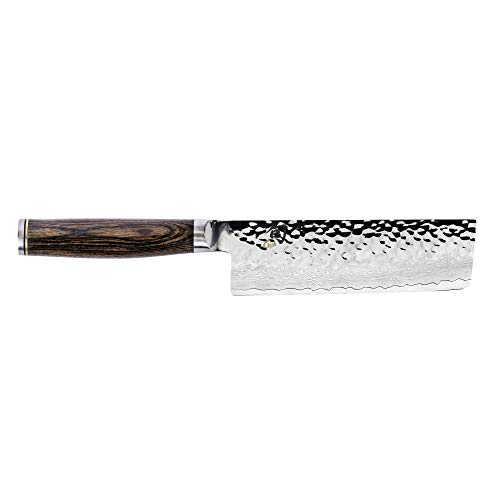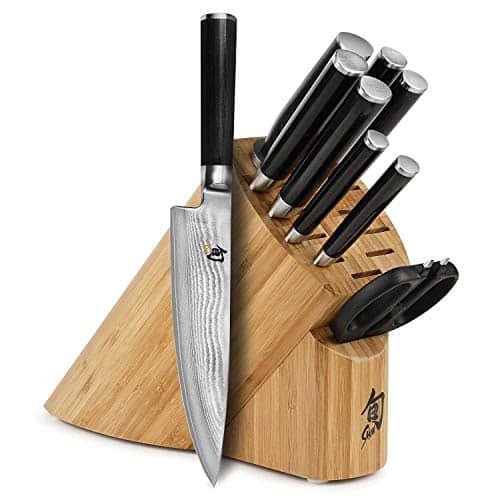Shun’s knives are some of the best of the best, but their Classic and Premier knife lines are often mistaken for one another due to their similarities. Which is better overall, and which should you choose for your next kitchen purchase? Let’s find out.
Shun Knives Overview
Shun Cutlery is one of the most well-known and beloved modern knife-making companies in the world. Their knives are known not only for their wonderful sharpness and applicability to precision kitchen tasks, but also for their aesthetic beauty and durability. Indeed, most Shun knives possess wonderfully sharp edges along with Damascus or hammered finishes, plus wood or wood-and-synthetic handles. All told, their knives are phenomenal across the board.
Shun Classic
Ultimately, both the Shun Classic and Premier knife lines are pretty similar in most major respects. For instance, both of these knife collections have blades that are made with 68 layers of cladded steel: this is what creates the Damascus finish that makes the steel look like it’s flowing in waves over the knife surface. Such cladding increases the blade’s durability, makes any knife with the finish look cool, and makes it harder for food to stick to a knife’s surface.
Additionally, Classic and Premier knives include full tangs – the steel goes from the tip of the knife to the very butt of the handle for extra balance and durability. The knives also feature similar cutting angles at about 16° per side. This is sharper than most other German-style knives, for comparison, though a few producers can match them.
When it comes to handles, both knives feature PakkaWood grips with steel end caps. There are a few differences in addition to all these similarities, however.
For instance, the Shun Classic knives have a generally more subtle Damascus finish. They also usually have black or very light brown handles. Their handles are straight and have a D-shaped grip, which provides the user with a little extra control and stability. Lastly, Classic knives are usually a little cheaper on average compared to their Premier counterparts.
Shun Premier
The Premier knives also have Damascus finishes, but they’ll also often be combined with hammered knife finishes. This creates even more rippling indentations on the top half of these knives, which makes a different but very noticeable aesthetic. However, it doesn’t directly affect durability or cutting potential.
They also have slightly different handle designs. Most Shun Premier knives have middling brown handle colors, though they’re made with the same materials. They also feature a more curved shape, which may be a little more comfortable at the expense of a little less control and stability. Lastly, these knives are a little more expensive on average compared to Classic blades.
If you want to learn more about Shun, check our full comparison between Shun and Miyabi or our complete Shun knives review.
Shun Classic vs Premier Chef’s Knives
1. Shun Classic 8” Chef’s Knife 
Chef’s knives like this one are suitable for a wide variety of kitchen tasks. As staple blades, they’re great for chopping, dicing, slicing, and almost anything else you can imagine. This knife, in particular, has an 8-inch blade, which is the most popular size. It’s made with wonderful steel, featuring a mixture of several metal types like vanadium and chromium to improve strength and corrosion resistance. The blade’s edge is suitably sharp, as you would expect from a Shun knife.
It also features an ebony PakkaWood handle. This looks quite stark and aesthetically interesting, but it’s also pretty easy to hold at tricky angles thanks to its straight shape. The wood handle has also been infused with a resin to imbue the handle with water resistance. Because of the shape, left and right-handed people can use it equally well.
Lastly, the mild Damascus finish ensures that the blade will retain its durability over the long-term, and food will not easily stick to the surface. Overall, it’s a quality chef’s knife that Japanese blade connoisseurs will really appreciate.
Pros:
- Very good steel quality
- The handle is easy to hold and water-resistant
- The knife-edge is sharp and durable
- Damascus finishes aesthetically pleasing and useful
Cons:
- Handle not super comfortable to hold for long sessions
2. Shun Premier Chef’s Knife, 8 Inches
This Shun Premier knife is the same size as the last chef’s knife, though it’s more expensive. However, the blade comes with an additional layer of hammered steel. This provides it with a startling aesthetic that does an even better job of keeping food off the knife’s sides. Handling stickier food is made even easier as a result.
It also features a walnut colored handle that has a slight curve to make it rest more easily in your hand. As a result, it’s a slightly better knife for longer kitchen prep sessions. The steel used here is also quite durable, and the edge of the knife is very sharp overall.
Pros:
- Very good steel aesthetic and durability
- Handle looks great and is comfortable
- Very well balanced
- The knife-edge is super sharp
Cons:
- Quite expensive for a single knife
Summary
This is a bit of a toss-up, but we’d say the Classic knife is a slightly better choice for most people since it does almost everything that the Premier blade does, and just as well. It’s just much more affordable. The Premier blade does look quite nice with its mixed Damascus and hammered finish, though.
If you are interested to read more of our articles you can check our selections about the best knives under $100 or the best Damascus knives.
Shun Classic vs Premier Nakiri Knives
1. Shun Cutlery Classic 6.5” Nakiri Knife
Nakiri knives, like this one, are Japanese blades that are usually utilized to cut various vegetables. This particular Classic blade is well suited to the task, featuring a hand-sharpened, double-beveled steel blade that will allow you to swiftly chop through a variety of hard food items and vegetables quickly. The blade is corrosion resistant and features the same soft Damascus finish mentioned earlier.
It also comes with a straight, ebony wooden handle with a water-resistant resin and a steel cap. The knife is very well balanced, so it’s great if you need to cut through lots of vegetable items quickly and with precision. Its only real downside is the asking price, which is comparatively affordable for other high-quality knives of this style, but still not really “budget-friendly”. Most Shun blades are more pricy than affordable, however.
Pros:
- Very durable handle and blade
- Soft Damascus finish looks good and is useful
- Blade steel is high-quality and produces a sharp edge
- Well balanced
Cons:
- A bit pricy
2. Shun Premier Nakiri Knife, 5.5 Inches 
This blade is more expensive than the last, so it’ll only be a viable option for professional chefs that want the best of the best. Yet you do get one of the highest quality knives should you choose to purchase this blade. It comes with a Damascus and hammered finish that ensures no food will ever stick to the blade’s sides.
Furthermore, this knife is a little shorter than the other. At 5.5 inches, it’s even more balanced since the handle is the same size, but the knife’s overall weight is lower. This means you can move it faster and with even more precision. When you add in the fact that it comes with a slightly curved wooden handle, you’ll find this knife is a lot more comfortable use.
Pros:
- Very comfortable to hold over long sessions
- Very well balanced overall
- Knife finishes are useful and aesthetically interesting
- Very secure grip
Cons:
- Even more expensive
Summary
All in all, the Premier Nakiri knife is slightly better between these two choices, but only if you can stomach the high asking price. It’s simply more maneuverable and is a great pick for chefs that spend one or more hours every night chopping through a wide variety of vegetables.
Wrapping Up our Shun Classic vs Premier Comparison
All in all, either the Shun Classic or Premier knives will be a great choice if you want to add some quality blades to your collection. Both lines are made with top-tier materials and, unlike many other knife manufacturers, don’t differ in their production process or quality control. The differences are only in the general asking price, the handle shape, and the ending finish for the blades.
To find out more about kitchen knives have a look at our reccomendation of the 7 best kitchen knives under $100 or our review of Hampton Forge knife set.

Gary Portman is the founder and main author of Knivesadvice.com. With his extensive knowledge and experience, he is committed to assisting people in choosing the perfect knife for their needs. Through his articles, Gary shares valuable insights on various aspects of knives. With his expertise, readers can make informed decisions and find a knife that is tailored to their preferences and requirements. You can find more info about Gary here.

